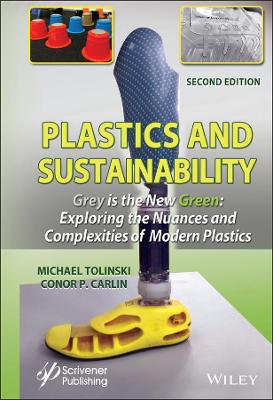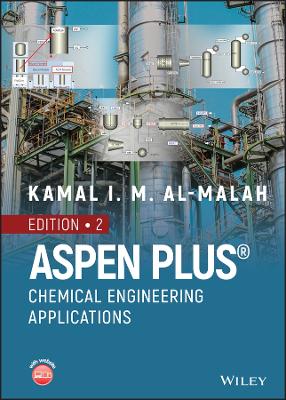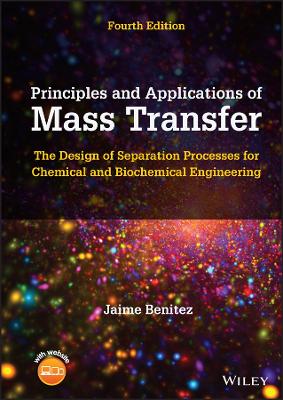Plastics and Sustainability Grey is the New Green
 -15%
portes grátis
-15%
portes grátis
Plastics and Sustainability Grey is the New Green
Exploring the Nuances and Complexities of Modern Plastics
Tolinski, Michael; Carlin, Conor P.
John Wiley & Sons Inc
04/2021
288
Dura
Inglês
9781119591849
15 a 20 dias
546
Descrição não disponível.
Acknowledgements xi
Notes on the 2nd Edition xiii
Preface xv
1 General Introduction 1
1.1 The Contradictions of Plastics 3
1.2 Plastics and the Consumer Lifestyle 4
1.3 Plastics Controversies 7
1.3.1 PVC and Phthalate Plasticizers 9
1.3.2 Plastic Shopping Bags 10
1.3.3 Health Effects of BPA (Bisphenol-A) 13
1.4 The Desire to be Green 15
1.4.1 Consumer Interest in Sustainability 15
1.4.2 Sustainability: Views and Counterviews 18
1.5 The Course of This Book 24
References 26
2 Plastic Life Cycles 29
2.1 Green Principles 30
2.2 Life Cycle Assessment (LCA) 34
2.2.1 Life Cycle Inventory (LCI) 36
2.2.2 LCA: Controversies and Limitations 37
2.2.3 LCA/LCI: Plastics-Related Examples 40
2.2.3.1 PET and HDPE 40
2.2.3.2 Bio/Fossil-Fuel Polymer Comparison 41
2.3 Plastic Lifetimes 42
2.3.1 The "Cradle": Polymer Feedstocks and Production 42
2.3.1.1 Fossil-Fuel Feedstock Sources 43
2.3.1.2 Bio-Based Feedstock Sources 44
2.3.2 "Gate-to-Gate": General Plastics Use-Life Impacts 46
2.3.3 The "Grave": Disposal, Recycling, and Biodegradability 48
2.3.3.1 "Permanent" Disposal? 48
2.3.3.2 Biodegradable Plastics 49
2.3.3.3 Recycling 51
2.3.3.4 Limitations and Challenges 56
2.4 A Hierarchy of Plastics for Sustainability 62
References 63
3 Polymer Properties and Environmental Footprints 67
3.1 Background on Polymers and Plastics 68
3.1.1 Green Chemistry Principles 70
3.2 Common Commodity Thermoplastics 74
3.2.1 Polyethylene (PE) 74
3.2.1.1 Synthesis 74
3.2.1.2 Structure and Properties 77
3.2.1.3 End-of-Life 77
3.2.2 Polypropylene (PP) 79
3.2.2.1 Synthesis 79
3.2.2.2 Structure and Properties 80
3.2.2.3 End-of-Life 80
3.2.3 Polyvinyl Chloride (PVC, or "Vinyl") 81
3.2.3.1 Synthesis 82
3.2.3.2 End-of-Life 85
3.2.4 Polystyrene (PS) 85
3.2.4.1 Synthesis 85
3.2.4.2 End-of-Life 86
3.2.5 Polyethylene Terephthalate (PET) and Related Polyesters 87
3.2.5.1 Synthesis 87
3.2.5.2 End-of-Life 89
3.3 Traditional Engineering Thermoplastics 90
3.3.1 Nylon or Polyamide (PA) 90
3.3.1.1 Synthesis 90
3.3.1.2 End-of-Life 91
3.3.2 Acrylonitrile-Butadiene-Styrene (ABS) 92
3.3.2.1 Synthesis 92
3.3.2.2 End-of-Life 93
3.3.3 Polycarbonate (PC) 93
3.3.3.1 Synthesis 93
3.3.3.2 End-of-Life 94
3.4 Traditional Thermosets and Conventional Composites 94
3.4.1 Unreinforced Thermosets 95
3.4.1.1 Synthesis 95
3.4.1.2 End-of-Life 96
3.4.2 Conventional Composites 97
3.4.2.1 Production 97
3.4.2.2 End-of-Life 97
3.5 Biopolymers: Polymers of Biological Origin 98
3.5.1 Polylactic Acid (PLA) 101
3.5.1.1 Synthesis 101
3.5.1.2 Structures and Properties 103
3.5.1.3 End-of-Life 104
3.5.2 Polyhydroxyalkanoates (PHAs): PHB and Related Copolymers 105
3.5.2.1 Synthesis 106
3.5.2.2 End-of-Life 107
3.5.3 Starch-Based Polymers 108
3.5.3.1 Synthesis 108
3.5.3.2 End-of-Life 108
3.5.4 Protein-Based Polymers 108
3.5.4.1 Synthesis 109
3.5.4.2 End-of-Life 109
3.5.5 Algae-Based Polymers 109
3.5.5.1 Synthesis 109
3.5.5.2 End-of-Life 110
3.5.6 Blends of Biopolymers 110
3.6 Additives and Fillers: Conventional and Bio-Based 111
3.6.1 Common Additives 111
3.6.2 Fillers 113
3.6.3 Fiber Reinforcement 114
3.6.3.1 Glass and Carbon Fiber 114
3.6.3.2 Natural Fiber Reinforcement 115
3.6.4 Nanocomposites 119
3.7 Concluding Summary 119
References 120
4 Applications: Demonstrations of Plastics Sustainability 127
4.1 Trends in Sustainable Plastics Applications 130
4.2 Sustainable Plastics Packaging 131
4.2.1 Plastic Bags and Containers 134
4.2.2 Bio-Based Plastic Packaging 136
4.2.3 "Greener" Foam Packaging 139
4.2.4 Key Points 140
4.3 Sustainable Plastics in Building and Construction 141
4.3.1 Recycled/Recyclable Construction Applications 143
4.3.2 Wood-Plastic Composites 144
4.3.3 Key Points 145
4.4 Automotive Plastics and Sustainability 146
4.4.1 Fuel-Saving Contributions of Plastics 146
4.4.2 Recycling and Automotive Plastics 147
4.4.3 Bioplastics in the Automotive Industry 149
4.4.4 Key Points 150
4.5 Specialized Applications and Plastics Sustainability 151
4.5.1 Electrical/Electronics Applications 151
4.5.2 Medical Plastics and Packaging 152
4.5.3 Agricultural Applications 154
4.6 Conclusions about Sustainable Plastics Applications 155
References 156
5 Design Guidelines for Sustainability 159
5.1 Green Design Principles 161
5.1.1 Minimize Material Content 163
5.1.2 Exploit a Material's Full Value 164
5.1.3 Fulfill Durability Requirements 166
5.1.4 Minimize Non-Functional Features 168
5.1.5 Focus on Single-Material Designs 168
5.1.6 Incorporate Renewable Content 171
5.2 Consumer Preferences in Green Design 172
References 173
6 Sustainable Considerations in Material Selection 175
6.1 Examples: Plastics vs. Metals and Glass 178
6.2 High Volume Plastics Applications 180
6.2.1 Beverage Bottles: PET vs. rPET vs. Bio-PET 180
6.2.2 Thermoformed and Flexible Packaging 183
6.2.3 Housewares and Food Service Tableware 186
6.3 Bio-Based Plastic Selection 188
6.3.1 Bio-Based Resins: PLA, PHA, TPS, PE 188
6.3.2 Natural Fiber Plastics Reinforcement 193
6.3.3 Engineering (Bio)polymers 196
6.4 The Selection Process: A Visual Approach 198
References 202
7 Processing: Increasing Efficiency in the Use of Energy and Materials 205
7.1 Optimizing Resin Recycling 206
7.1.1 Reprocessing Scrap and Post-Industrial Material 206
7.1.2 Recycling Post-Consumer Plastic 208
7.1.2.1 The Recycled Resin Challenge 212
7.1.3 Advanced Recycling 213
7.1.3.1 Dissolution ("Advanced Physical Recycling") 213
7.1.3.2 Depolymerization ("Chemical or Molecular Recycling") 214
7.1.3.3 Gasification/Pyrolysis ("Chemical or Feedstock Recovery") 215
7.2 Optimizing Plastics Processes for Sustainability 216
7.2.1 Optimizing Water Use 216
7.2.2 Optimizing Energy Consumption 218
7.2.2.1 Refurbishing Equipment for Energy Savings 219
7.2.3 Choosing New Machinery for Sustainability 221
7.2.4 Sourcing Options for "Green" Energy 222
References 223
8 Conclusion: Grey is the New Green 225
8.1 Trends Affecting Future Global Plastics Use 226
8.1.1 Consumer Needs and Market Growth 227
8.1.2 Fossil Fuel Availability and Price 229
8.1.3 Alternative Feedstock Trends 232
8.1.4 Industry Priorities for Sustainability 233
8.1.5 Plastic Bans and Controversies 235
8.1.5.1 Bag Bans 235
8.1.5.2 Post-Consumer Plastic Recycling 236
8.2 Future Progress in Promoting Plastics Sustainability 238
8.2.1 Improved Partnerships 238
8.2.1.1 Increasing Recycling Rates 239
8.2.1.2 Plastic Litter: Minimizing the Damage 240
8.2.1.3 Educating the Public about Plastics and Sustainability 241
8.2.1.4 Implementing Bio-Based Materials 245
8.2.1.5 Improving the Life-Cycle Impact of Plastics 246
8.2.1.6 Sustainability in the Product Development Process 246
8.2.1.7 Effective Government Regulation 248
8.2.2 New Sustainability-Enhancing Approaches 248
8.2.2.1 Energy-Efficient Transportation 249
8.2.2.2 Flexible Solar-Energy Systems 250
8.2.3 New Research & Development 251
References 252
Index 255
Notes on the 2nd Edition xiii
Preface xv
1 General Introduction 1
1.1 The Contradictions of Plastics 3
1.2 Plastics and the Consumer Lifestyle 4
1.3 Plastics Controversies 7
1.3.1 PVC and Phthalate Plasticizers 9
1.3.2 Plastic Shopping Bags 10
1.3.3 Health Effects of BPA (Bisphenol-A) 13
1.4 The Desire to be Green 15
1.4.1 Consumer Interest in Sustainability 15
1.4.2 Sustainability: Views and Counterviews 18
1.5 The Course of This Book 24
References 26
2 Plastic Life Cycles 29
2.1 Green Principles 30
2.2 Life Cycle Assessment (LCA) 34
2.2.1 Life Cycle Inventory (LCI) 36
2.2.2 LCA: Controversies and Limitations 37
2.2.3 LCA/LCI: Plastics-Related Examples 40
2.2.3.1 PET and HDPE 40
2.2.3.2 Bio/Fossil-Fuel Polymer Comparison 41
2.3 Plastic Lifetimes 42
2.3.1 The "Cradle": Polymer Feedstocks and Production 42
2.3.1.1 Fossil-Fuel Feedstock Sources 43
2.3.1.2 Bio-Based Feedstock Sources 44
2.3.2 "Gate-to-Gate": General Plastics Use-Life Impacts 46
2.3.3 The "Grave": Disposal, Recycling, and Biodegradability 48
2.3.3.1 "Permanent" Disposal? 48
2.3.3.2 Biodegradable Plastics 49
2.3.3.3 Recycling 51
2.3.3.4 Limitations and Challenges 56
2.4 A Hierarchy of Plastics for Sustainability 62
References 63
3 Polymer Properties and Environmental Footprints 67
3.1 Background on Polymers and Plastics 68
3.1.1 Green Chemistry Principles 70
3.2 Common Commodity Thermoplastics 74
3.2.1 Polyethylene (PE) 74
3.2.1.1 Synthesis 74
3.2.1.2 Structure and Properties 77
3.2.1.3 End-of-Life 77
3.2.2 Polypropylene (PP) 79
3.2.2.1 Synthesis 79
3.2.2.2 Structure and Properties 80
3.2.2.3 End-of-Life 80
3.2.3 Polyvinyl Chloride (PVC, or "Vinyl") 81
3.2.3.1 Synthesis 82
3.2.3.2 End-of-Life 85
3.2.4 Polystyrene (PS) 85
3.2.4.1 Synthesis 85
3.2.4.2 End-of-Life 86
3.2.5 Polyethylene Terephthalate (PET) and Related Polyesters 87
3.2.5.1 Synthesis 87
3.2.5.2 End-of-Life 89
3.3 Traditional Engineering Thermoplastics 90
3.3.1 Nylon or Polyamide (PA) 90
3.3.1.1 Synthesis 90
3.3.1.2 End-of-Life 91
3.3.2 Acrylonitrile-Butadiene-Styrene (ABS) 92
3.3.2.1 Synthesis 92
3.3.2.2 End-of-Life 93
3.3.3 Polycarbonate (PC) 93
3.3.3.1 Synthesis 93
3.3.3.2 End-of-Life 94
3.4 Traditional Thermosets and Conventional Composites 94
3.4.1 Unreinforced Thermosets 95
3.4.1.1 Synthesis 95
3.4.1.2 End-of-Life 96
3.4.2 Conventional Composites 97
3.4.2.1 Production 97
3.4.2.2 End-of-Life 97
3.5 Biopolymers: Polymers of Biological Origin 98
3.5.1 Polylactic Acid (PLA) 101
3.5.1.1 Synthesis 101
3.5.1.2 Structures and Properties 103
3.5.1.3 End-of-Life 104
3.5.2 Polyhydroxyalkanoates (PHAs): PHB and Related Copolymers 105
3.5.2.1 Synthesis 106
3.5.2.2 End-of-Life 107
3.5.3 Starch-Based Polymers 108
3.5.3.1 Synthesis 108
3.5.3.2 End-of-Life 108
3.5.4 Protein-Based Polymers 108
3.5.4.1 Synthesis 109
3.5.4.2 End-of-Life 109
3.5.5 Algae-Based Polymers 109
3.5.5.1 Synthesis 109
3.5.5.2 End-of-Life 110
3.5.6 Blends of Biopolymers 110
3.6 Additives and Fillers: Conventional and Bio-Based 111
3.6.1 Common Additives 111
3.6.2 Fillers 113
3.6.3 Fiber Reinforcement 114
3.6.3.1 Glass and Carbon Fiber 114
3.6.3.2 Natural Fiber Reinforcement 115
3.6.4 Nanocomposites 119
3.7 Concluding Summary 119
References 120
4 Applications: Demonstrations of Plastics Sustainability 127
4.1 Trends in Sustainable Plastics Applications 130
4.2 Sustainable Plastics Packaging 131
4.2.1 Plastic Bags and Containers 134
4.2.2 Bio-Based Plastic Packaging 136
4.2.3 "Greener" Foam Packaging 139
4.2.4 Key Points 140
4.3 Sustainable Plastics in Building and Construction 141
4.3.1 Recycled/Recyclable Construction Applications 143
4.3.2 Wood-Plastic Composites 144
4.3.3 Key Points 145
4.4 Automotive Plastics and Sustainability 146
4.4.1 Fuel-Saving Contributions of Plastics 146
4.4.2 Recycling and Automotive Plastics 147
4.4.3 Bioplastics in the Automotive Industry 149
4.4.4 Key Points 150
4.5 Specialized Applications and Plastics Sustainability 151
4.5.1 Electrical/Electronics Applications 151
4.5.2 Medical Plastics and Packaging 152
4.5.3 Agricultural Applications 154
4.6 Conclusions about Sustainable Plastics Applications 155
References 156
5 Design Guidelines for Sustainability 159
5.1 Green Design Principles 161
5.1.1 Minimize Material Content 163
5.1.2 Exploit a Material's Full Value 164
5.1.3 Fulfill Durability Requirements 166
5.1.4 Minimize Non-Functional Features 168
5.1.5 Focus on Single-Material Designs 168
5.1.6 Incorporate Renewable Content 171
5.2 Consumer Preferences in Green Design 172
References 173
6 Sustainable Considerations in Material Selection 175
6.1 Examples: Plastics vs. Metals and Glass 178
6.2 High Volume Plastics Applications 180
6.2.1 Beverage Bottles: PET vs. rPET vs. Bio-PET 180
6.2.2 Thermoformed and Flexible Packaging 183
6.2.3 Housewares and Food Service Tableware 186
6.3 Bio-Based Plastic Selection 188
6.3.1 Bio-Based Resins: PLA, PHA, TPS, PE 188
6.3.2 Natural Fiber Plastics Reinforcement 193
6.3.3 Engineering (Bio)polymers 196
6.4 The Selection Process: A Visual Approach 198
References 202
7 Processing: Increasing Efficiency in the Use of Energy and Materials 205
7.1 Optimizing Resin Recycling 206
7.1.1 Reprocessing Scrap and Post-Industrial Material 206
7.1.2 Recycling Post-Consumer Plastic 208
7.1.2.1 The Recycled Resin Challenge 212
7.1.3 Advanced Recycling 213
7.1.3.1 Dissolution ("Advanced Physical Recycling") 213
7.1.3.2 Depolymerization ("Chemical or Molecular Recycling") 214
7.1.3.3 Gasification/Pyrolysis ("Chemical or Feedstock Recovery") 215
7.2 Optimizing Plastics Processes for Sustainability 216
7.2.1 Optimizing Water Use 216
7.2.2 Optimizing Energy Consumption 218
7.2.2.1 Refurbishing Equipment for Energy Savings 219
7.2.3 Choosing New Machinery for Sustainability 221
7.2.4 Sourcing Options for "Green" Energy 222
References 223
8 Conclusion: Grey is the New Green 225
8.1 Trends Affecting Future Global Plastics Use 226
8.1.1 Consumer Needs and Market Growth 227
8.1.2 Fossil Fuel Availability and Price 229
8.1.3 Alternative Feedstock Trends 232
8.1.4 Industry Priorities for Sustainability 233
8.1.5 Plastic Bans and Controversies 235
8.1.5.1 Bag Bans 235
8.1.5.2 Post-Consumer Plastic Recycling 236
8.2 Future Progress in Promoting Plastics Sustainability 238
8.2.1 Improved Partnerships 238
8.2.1.1 Increasing Recycling Rates 239
8.2.1.2 Plastic Litter: Minimizing the Damage 240
8.2.1.3 Educating the Public about Plastics and Sustainability 241
8.2.1.4 Implementing Bio-Based Materials 245
8.2.1.5 Improving the Life-Cycle Impact of Plastics 246
8.2.1.6 Sustainability in the Product Development Process 246
8.2.1.7 Effective Government Regulation 248
8.2.2 New Sustainability-Enhancing Approaches 248
8.2.2.1 Energy-Efficient Transportation 249
8.2.2.2 Flexible Solar-Energy Systems 250
8.2.3 New Research & Development 251
References 252
Index 255
Este título pertence ao(s) assunto(s) indicados(s). Para ver outros títulos clique no assunto desejado.
Plastics; Packaging; Sustainability; Recycling; Mechanical recycling; Chemical recycling; Green chemistry; Life Cycle Assessment; Life Cycle Analysis; Life Cycle Inventory; Biobased materials; Bioplastics; Biodegradable materials; Fossil fuels; Landfill; Incineration; Greenhouse gas emissions; Petroleum; Natural gas; Oil; Feedstocks; Composting; Compostability; PLA; PP; PE; PET; Bottles; Clamshells; Automotive plastics
Acknowledgements xi
Notes on the 2nd Edition xiii
Preface xv
1 General Introduction 1
1.1 The Contradictions of Plastics 3
1.2 Plastics and the Consumer Lifestyle 4
1.3 Plastics Controversies 7
1.3.1 PVC and Phthalate Plasticizers 9
1.3.2 Plastic Shopping Bags 10
1.3.3 Health Effects of BPA (Bisphenol-A) 13
1.4 The Desire to be Green 15
1.4.1 Consumer Interest in Sustainability 15
1.4.2 Sustainability: Views and Counterviews 18
1.5 The Course of This Book 24
References 26
2 Plastic Life Cycles 29
2.1 Green Principles 30
2.2 Life Cycle Assessment (LCA) 34
2.2.1 Life Cycle Inventory (LCI) 36
2.2.2 LCA: Controversies and Limitations 37
2.2.3 LCA/LCI: Plastics-Related Examples 40
2.2.3.1 PET and HDPE 40
2.2.3.2 Bio/Fossil-Fuel Polymer Comparison 41
2.3 Plastic Lifetimes 42
2.3.1 The "Cradle": Polymer Feedstocks and Production 42
2.3.1.1 Fossil-Fuel Feedstock Sources 43
2.3.1.2 Bio-Based Feedstock Sources 44
2.3.2 "Gate-to-Gate": General Plastics Use-Life Impacts 46
2.3.3 The "Grave": Disposal, Recycling, and Biodegradability 48
2.3.3.1 "Permanent" Disposal? 48
2.3.3.2 Biodegradable Plastics 49
2.3.3.3 Recycling 51
2.3.3.4 Limitations and Challenges 56
2.4 A Hierarchy of Plastics for Sustainability 62
References 63
3 Polymer Properties and Environmental Footprints 67
3.1 Background on Polymers and Plastics 68
3.1.1 Green Chemistry Principles 70
3.2 Common Commodity Thermoplastics 74
3.2.1 Polyethylene (PE) 74
3.2.1.1 Synthesis 74
3.2.1.2 Structure and Properties 77
3.2.1.3 End-of-Life 77
3.2.2 Polypropylene (PP) 79
3.2.2.1 Synthesis 79
3.2.2.2 Structure and Properties 80
3.2.2.3 End-of-Life 80
3.2.3 Polyvinyl Chloride (PVC, or "Vinyl") 81
3.2.3.1 Synthesis 82
3.2.3.2 End-of-Life 85
3.2.4 Polystyrene (PS) 85
3.2.4.1 Synthesis 85
3.2.4.2 End-of-Life 86
3.2.5 Polyethylene Terephthalate (PET) and Related Polyesters 87
3.2.5.1 Synthesis 87
3.2.5.2 End-of-Life 89
3.3 Traditional Engineering Thermoplastics 90
3.3.1 Nylon or Polyamide (PA) 90
3.3.1.1 Synthesis 90
3.3.1.2 End-of-Life 91
3.3.2 Acrylonitrile-Butadiene-Styrene (ABS) 92
3.3.2.1 Synthesis 92
3.3.2.2 End-of-Life 93
3.3.3 Polycarbonate (PC) 93
3.3.3.1 Synthesis 93
3.3.3.2 End-of-Life 94
3.4 Traditional Thermosets and Conventional Composites 94
3.4.1 Unreinforced Thermosets 95
3.4.1.1 Synthesis 95
3.4.1.2 End-of-Life 96
3.4.2 Conventional Composites 97
3.4.2.1 Production 97
3.4.2.2 End-of-Life 97
3.5 Biopolymers: Polymers of Biological Origin 98
3.5.1 Polylactic Acid (PLA) 101
3.5.1.1 Synthesis 101
3.5.1.2 Structures and Properties 103
3.5.1.3 End-of-Life 104
3.5.2 Polyhydroxyalkanoates (PHAs): PHB and Related Copolymers 105
3.5.2.1 Synthesis 106
3.5.2.2 End-of-Life 107
3.5.3 Starch-Based Polymers 108
3.5.3.1 Synthesis 108
3.5.3.2 End-of-Life 108
3.5.4 Protein-Based Polymers 108
3.5.4.1 Synthesis 109
3.5.4.2 End-of-Life 109
3.5.5 Algae-Based Polymers 109
3.5.5.1 Synthesis 109
3.5.5.2 End-of-Life 110
3.5.6 Blends of Biopolymers 110
3.6 Additives and Fillers: Conventional and Bio-Based 111
3.6.1 Common Additives 111
3.6.2 Fillers 113
3.6.3 Fiber Reinforcement 114
3.6.3.1 Glass and Carbon Fiber 114
3.6.3.2 Natural Fiber Reinforcement 115
3.6.4 Nanocomposites 119
3.7 Concluding Summary 119
References 120
4 Applications: Demonstrations of Plastics Sustainability 127
4.1 Trends in Sustainable Plastics Applications 130
4.2 Sustainable Plastics Packaging 131
4.2.1 Plastic Bags and Containers 134
4.2.2 Bio-Based Plastic Packaging 136
4.2.3 "Greener" Foam Packaging 139
4.2.4 Key Points 140
4.3 Sustainable Plastics in Building and Construction 141
4.3.1 Recycled/Recyclable Construction Applications 143
4.3.2 Wood-Plastic Composites 144
4.3.3 Key Points 145
4.4 Automotive Plastics and Sustainability 146
4.4.1 Fuel-Saving Contributions of Plastics 146
4.4.2 Recycling and Automotive Plastics 147
4.4.3 Bioplastics in the Automotive Industry 149
4.4.4 Key Points 150
4.5 Specialized Applications and Plastics Sustainability 151
4.5.1 Electrical/Electronics Applications 151
4.5.2 Medical Plastics and Packaging 152
4.5.3 Agricultural Applications 154
4.6 Conclusions about Sustainable Plastics Applications 155
References 156
5 Design Guidelines for Sustainability 159
5.1 Green Design Principles 161
5.1.1 Minimize Material Content 163
5.1.2 Exploit a Material's Full Value 164
5.1.3 Fulfill Durability Requirements 166
5.1.4 Minimize Non-Functional Features 168
5.1.5 Focus on Single-Material Designs 168
5.1.6 Incorporate Renewable Content 171
5.2 Consumer Preferences in Green Design 172
References 173
6 Sustainable Considerations in Material Selection 175
6.1 Examples: Plastics vs. Metals and Glass 178
6.2 High Volume Plastics Applications 180
6.2.1 Beverage Bottles: PET vs. rPET vs. Bio-PET 180
6.2.2 Thermoformed and Flexible Packaging 183
6.2.3 Housewares and Food Service Tableware 186
6.3 Bio-Based Plastic Selection 188
6.3.1 Bio-Based Resins: PLA, PHA, TPS, PE 188
6.3.2 Natural Fiber Plastics Reinforcement 193
6.3.3 Engineering (Bio)polymers 196
6.4 The Selection Process: A Visual Approach 198
References 202
7 Processing: Increasing Efficiency in the Use of Energy and Materials 205
7.1 Optimizing Resin Recycling 206
7.1.1 Reprocessing Scrap and Post-Industrial Material 206
7.1.2 Recycling Post-Consumer Plastic 208
7.1.2.1 The Recycled Resin Challenge 212
7.1.3 Advanced Recycling 213
7.1.3.1 Dissolution ("Advanced Physical Recycling") 213
7.1.3.2 Depolymerization ("Chemical or Molecular Recycling") 214
7.1.3.3 Gasification/Pyrolysis ("Chemical or Feedstock Recovery") 215
7.2 Optimizing Plastics Processes for Sustainability 216
7.2.1 Optimizing Water Use 216
7.2.2 Optimizing Energy Consumption 218
7.2.2.1 Refurbishing Equipment for Energy Savings 219
7.2.3 Choosing New Machinery for Sustainability 221
7.2.4 Sourcing Options for "Green" Energy 222
References 223
8 Conclusion: Grey is the New Green 225
8.1 Trends Affecting Future Global Plastics Use 226
8.1.1 Consumer Needs and Market Growth 227
8.1.2 Fossil Fuel Availability and Price 229
8.1.3 Alternative Feedstock Trends 232
8.1.4 Industry Priorities for Sustainability 233
8.1.5 Plastic Bans and Controversies 235
8.1.5.1 Bag Bans 235
8.1.5.2 Post-Consumer Plastic Recycling 236
8.2 Future Progress in Promoting Plastics Sustainability 238
8.2.1 Improved Partnerships 238
8.2.1.1 Increasing Recycling Rates 239
8.2.1.2 Plastic Litter: Minimizing the Damage 240
8.2.1.3 Educating the Public about Plastics and Sustainability 241
8.2.1.4 Implementing Bio-Based Materials 245
8.2.1.5 Improving the Life-Cycle Impact of Plastics 246
8.2.1.6 Sustainability in the Product Development Process 246
8.2.1.7 Effective Government Regulation 248
8.2.2 New Sustainability-Enhancing Approaches 248
8.2.2.1 Energy-Efficient Transportation 249
8.2.2.2 Flexible Solar-Energy Systems 250
8.2.3 New Research & Development 251
References 252
Index 255
Notes on the 2nd Edition xiii
Preface xv
1 General Introduction 1
1.1 The Contradictions of Plastics 3
1.2 Plastics and the Consumer Lifestyle 4
1.3 Plastics Controversies 7
1.3.1 PVC and Phthalate Plasticizers 9
1.3.2 Plastic Shopping Bags 10
1.3.3 Health Effects of BPA (Bisphenol-A) 13
1.4 The Desire to be Green 15
1.4.1 Consumer Interest in Sustainability 15
1.4.2 Sustainability: Views and Counterviews 18
1.5 The Course of This Book 24
References 26
2 Plastic Life Cycles 29
2.1 Green Principles 30
2.2 Life Cycle Assessment (LCA) 34
2.2.1 Life Cycle Inventory (LCI) 36
2.2.2 LCA: Controversies and Limitations 37
2.2.3 LCA/LCI: Plastics-Related Examples 40
2.2.3.1 PET and HDPE 40
2.2.3.2 Bio/Fossil-Fuel Polymer Comparison 41
2.3 Plastic Lifetimes 42
2.3.1 The "Cradle": Polymer Feedstocks and Production 42
2.3.1.1 Fossil-Fuel Feedstock Sources 43
2.3.1.2 Bio-Based Feedstock Sources 44
2.3.2 "Gate-to-Gate": General Plastics Use-Life Impacts 46
2.3.3 The "Grave": Disposal, Recycling, and Biodegradability 48
2.3.3.1 "Permanent" Disposal? 48
2.3.3.2 Biodegradable Plastics 49
2.3.3.3 Recycling 51
2.3.3.4 Limitations and Challenges 56
2.4 A Hierarchy of Plastics for Sustainability 62
References 63
3 Polymer Properties and Environmental Footprints 67
3.1 Background on Polymers and Plastics 68
3.1.1 Green Chemistry Principles 70
3.2 Common Commodity Thermoplastics 74
3.2.1 Polyethylene (PE) 74
3.2.1.1 Synthesis 74
3.2.1.2 Structure and Properties 77
3.2.1.3 End-of-Life 77
3.2.2 Polypropylene (PP) 79
3.2.2.1 Synthesis 79
3.2.2.2 Structure and Properties 80
3.2.2.3 End-of-Life 80
3.2.3 Polyvinyl Chloride (PVC, or "Vinyl") 81
3.2.3.1 Synthesis 82
3.2.3.2 End-of-Life 85
3.2.4 Polystyrene (PS) 85
3.2.4.1 Synthesis 85
3.2.4.2 End-of-Life 86
3.2.5 Polyethylene Terephthalate (PET) and Related Polyesters 87
3.2.5.1 Synthesis 87
3.2.5.2 End-of-Life 89
3.3 Traditional Engineering Thermoplastics 90
3.3.1 Nylon or Polyamide (PA) 90
3.3.1.1 Synthesis 90
3.3.1.2 End-of-Life 91
3.3.2 Acrylonitrile-Butadiene-Styrene (ABS) 92
3.3.2.1 Synthesis 92
3.3.2.2 End-of-Life 93
3.3.3 Polycarbonate (PC) 93
3.3.3.1 Synthesis 93
3.3.3.2 End-of-Life 94
3.4 Traditional Thermosets and Conventional Composites 94
3.4.1 Unreinforced Thermosets 95
3.4.1.1 Synthesis 95
3.4.1.2 End-of-Life 96
3.4.2 Conventional Composites 97
3.4.2.1 Production 97
3.4.2.2 End-of-Life 97
3.5 Biopolymers: Polymers of Biological Origin 98
3.5.1 Polylactic Acid (PLA) 101
3.5.1.1 Synthesis 101
3.5.1.2 Structures and Properties 103
3.5.1.3 End-of-Life 104
3.5.2 Polyhydroxyalkanoates (PHAs): PHB and Related Copolymers 105
3.5.2.1 Synthesis 106
3.5.2.2 End-of-Life 107
3.5.3 Starch-Based Polymers 108
3.5.3.1 Synthesis 108
3.5.3.2 End-of-Life 108
3.5.4 Protein-Based Polymers 108
3.5.4.1 Synthesis 109
3.5.4.2 End-of-Life 109
3.5.5 Algae-Based Polymers 109
3.5.5.1 Synthesis 109
3.5.5.2 End-of-Life 110
3.5.6 Blends of Biopolymers 110
3.6 Additives and Fillers: Conventional and Bio-Based 111
3.6.1 Common Additives 111
3.6.2 Fillers 113
3.6.3 Fiber Reinforcement 114
3.6.3.1 Glass and Carbon Fiber 114
3.6.3.2 Natural Fiber Reinforcement 115
3.6.4 Nanocomposites 119
3.7 Concluding Summary 119
References 120
4 Applications: Demonstrations of Plastics Sustainability 127
4.1 Trends in Sustainable Plastics Applications 130
4.2 Sustainable Plastics Packaging 131
4.2.1 Plastic Bags and Containers 134
4.2.2 Bio-Based Plastic Packaging 136
4.2.3 "Greener" Foam Packaging 139
4.2.4 Key Points 140
4.3 Sustainable Plastics in Building and Construction 141
4.3.1 Recycled/Recyclable Construction Applications 143
4.3.2 Wood-Plastic Composites 144
4.3.3 Key Points 145
4.4 Automotive Plastics and Sustainability 146
4.4.1 Fuel-Saving Contributions of Plastics 146
4.4.2 Recycling and Automotive Plastics 147
4.4.3 Bioplastics in the Automotive Industry 149
4.4.4 Key Points 150
4.5 Specialized Applications and Plastics Sustainability 151
4.5.1 Electrical/Electronics Applications 151
4.5.2 Medical Plastics and Packaging 152
4.5.3 Agricultural Applications 154
4.6 Conclusions about Sustainable Plastics Applications 155
References 156
5 Design Guidelines for Sustainability 159
5.1 Green Design Principles 161
5.1.1 Minimize Material Content 163
5.1.2 Exploit a Material's Full Value 164
5.1.3 Fulfill Durability Requirements 166
5.1.4 Minimize Non-Functional Features 168
5.1.5 Focus on Single-Material Designs 168
5.1.6 Incorporate Renewable Content 171
5.2 Consumer Preferences in Green Design 172
References 173
6 Sustainable Considerations in Material Selection 175
6.1 Examples: Plastics vs. Metals and Glass 178
6.2 High Volume Plastics Applications 180
6.2.1 Beverage Bottles: PET vs. rPET vs. Bio-PET 180
6.2.2 Thermoformed and Flexible Packaging 183
6.2.3 Housewares and Food Service Tableware 186
6.3 Bio-Based Plastic Selection 188
6.3.1 Bio-Based Resins: PLA, PHA, TPS, PE 188
6.3.2 Natural Fiber Plastics Reinforcement 193
6.3.3 Engineering (Bio)polymers 196
6.4 The Selection Process: A Visual Approach 198
References 202
7 Processing: Increasing Efficiency in the Use of Energy and Materials 205
7.1 Optimizing Resin Recycling 206
7.1.1 Reprocessing Scrap and Post-Industrial Material 206
7.1.2 Recycling Post-Consumer Plastic 208
7.1.2.1 The Recycled Resin Challenge 212
7.1.3 Advanced Recycling 213
7.1.3.1 Dissolution ("Advanced Physical Recycling") 213
7.1.3.2 Depolymerization ("Chemical or Molecular Recycling") 214
7.1.3.3 Gasification/Pyrolysis ("Chemical or Feedstock Recovery") 215
7.2 Optimizing Plastics Processes for Sustainability 216
7.2.1 Optimizing Water Use 216
7.2.2 Optimizing Energy Consumption 218
7.2.2.1 Refurbishing Equipment for Energy Savings 219
7.2.3 Choosing New Machinery for Sustainability 221
7.2.4 Sourcing Options for "Green" Energy 222
References 223
8 Conclusion: Grey is the New Green 225
8.1 Trends Affecting Future Global Plastics Use 226
8.1.1 Consumer Needs and Market Growth 227
8.1.2 Fossil Fuel Availability and Price 229
8.1.3 Alternative Feedstock Trends 232
8.1.4 Industry Priorities for Sustainability 233
8.1.5 Plastic Bans and Controversies 235
8.1.5.1 Bag Bans 235
8.1.5.2 Post-Consumer Plastic Recycling 236
8.2 Future Progress in Promoting Plastics Sustainability 238
8.2.1 Improved Partnerships 238
8.2.1.1 Increasing Recycling Rates 239
8.2.1.2 Plastic Litter: Minimizing the Damage 240
8.2.1.3 Educating the Public about Plastics and Sustainability 241
8.2.1.4 Implementing Bio-Based Materials 245
8.2.1.5 Improving the Life-Cycle Impact of Plastics 246
8.2.1.6 Sustainability in the Product Development Process 246
8.2.1.7 Effective Government Regulation 248
8.2.2 New Sustainability-Enhancing Approaches 248
8.2.2.1 Energy-Efficient Transportation 249
8.2.2.2 Flexible Solar-Energy Systems 250
8.2.3 New Research & Development 251
References 252
Index 255
Este título pertence ao(s) assunto(s) indicados(s). Para ver outros títulos clique no assunto desejado.
Plastics; Packaging; Sustainability; Recycling; Mechanical recycling; Chemical recycling; Green chemistry; Life Cycle Assessment; Life Cycle Analysis; Life Cycle Inventory; Biobased materials; Bioplastics; Biodegradable materials; Fossil fuels; Landfill; Incineration; Greenhouse gas emissions; Petroleum; Natural gas; Oil; Feedstocks; Composting; Compostability; PLA; PP; PE; PET; Bottles; Clamshells; Automotive plastics







